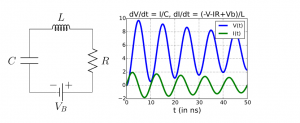3.2 Validation
Course subject(s)
3. Extending the model
Validation

On the last page, you have calculated for what values this LC-oscillator will oscillate with a frequency of 100MHz:
VB=5V, L=0.004μH, R=0.1Ω, and C=0.633nF.
This choosing of the right capacitance for the condensator is called tuning. In older radios this is done mechanically with a variable condensator, also called a tuning condensator.

Rotary capacitor by Zátonyi Sándor CC BY 3.0, Link
As you can see in the graph, the amplitude of the signal dies out, because however small, there is some energy loss because R≠0 (and in reality also some charge will leak from the capacitor). So this basic LC-oscillator will only work for say 500nanoseconds or so, which is not very long! To maintain the oscillation for longer times, other components (e.g. a transistor or an Opamp) are built into the circuit, to give the current little pushes at the right times, and keep the amplitude constant.
Oscillator circuits are not only used to set the clock speed in computers and electronic clocks and to tune radio and televisions, but also to generate those radio and television waves, and to generate the buzz of a door bell and the electronic beeps in video games.
And of course, modern oscillators are way more complicated than the one shown here. For example, often a quartz christal is cleverly used to keep the oscillations generated by the circuit really constant over longer times. Many of the components used nowadays in circuits are non-linear, and their mathematical models contain non-linear terms and the resulting waves are often far from nice, periodic sines or cosines. Very interesting to model!
Changing the resistance R
Untill now, we have kept the resistance R=0.1Ω. In the next exercises, let’s investigate what happens when R is changed.

Mathematical Modeling Basics by TU Delft OpenCourseWare is licensed under a Creative Commons Attribution-NonCommercial-ShareAlike 4.0 International License.
Based on a work at https://online-learning.tudelft.nl/courses/mathematical-modeling-basics/.



